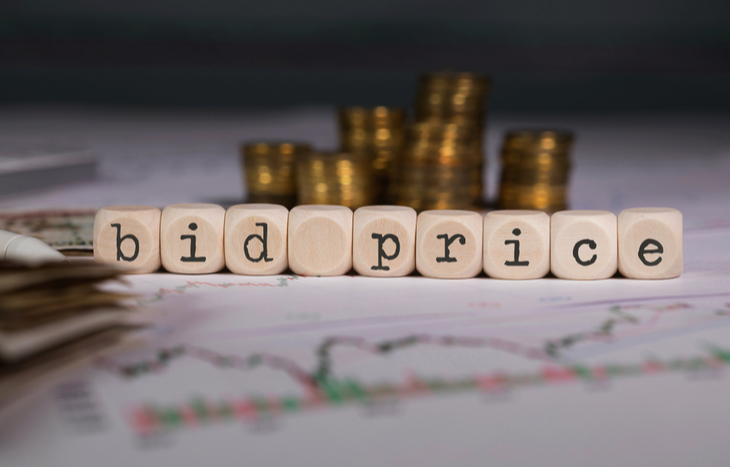What is Bid Price?
When you want to acquire an asset from a seller, you ask them what they’re selling it for. Then, you offer a bid: the highest price you, the buyer, is willing to pay for an investment. This simple interaction sets the foundation for asset markets of all types. Without ask and bid, there wouldn’t be transactions.
The bid price in a transaction plays an important role in shaping not only that transaction, but broader markets as a whole. It can enable or hamper an asset’s liquidity, drive market sentiment and help set the pricing floor of an asset. It represents demand.
It’s always lower than the ask price—every good investor knows you don’t pay more than a seller is willing to ask! Here’s how to navigate bid-ask spreads and identify situations where bidders control the playing field in asset transactions.

Bid Price vs. Ask Price
In every transaction, the bid price is the figure that makes or breaks the sale. If there is no bid, there is no sale! And, because it represents the buyer’s highest purchase amount, it sets the floor for the price of an asset. Conversely, the ask price establishes its ceiling, since no investor will exceed the asking price of the seller.
In direct transactions—such as the sale of goods or services—buyers and sellers need to agree. Therefore, bid and ask need to converge. When it comes to equities and transactions made through a broker, bid and ask don’t need to converge. Instead, market makers use the spread to facilitate the transaction. In either case, the goal of buyers is to obtain the asset for the lowest possible price.
Examples
Anyone who’s ever participated in a transaction without an established price has given a bid before. From the used item you bid for on eBay to haggling with the person who cuts your lawn, these prices help to establish final sales. Here’s what they look like in context.
- A stock has a bid price of $12.30 x 100; buyers will buy 100 shares at $12.30/each
- A property is on the market for $400,000; Jim offers a bid of $395,000 to the seller.
- Forex is contextualized within a currency pair, such as EUR/USD 1.1250/1.1251
What is the Bid-Ask Spread?
Asset transactions happen within a bid-ask spread: the real-time two-way price quote system that governs markets. Sellers specify an ask price and buyers counter with a bid. The distance between the two is the spread. Investors pay the ask price when they buy a security and receive the bid price when they sell. Market makers profit the difference to facilitate the transaction.
- Small spreads signal asset liquidity. A narrow difference in price means buyers and sellers agree on a fair market value for the asset. The lowest price a seller is willing to accept matches the highest price the buyer is willing to pay.
- Large spreads tend to mean more risk. When buyers and sellers struggle to close the spread, it means they disagree on the fair market value of an asset. These assets experience illiquidity as a result, since fewer transactions occur.
Bid-ask spreads vary among different investment vehicles. For example, a mid-cap stock in a struggling sector might have a bid-ask spread of several dollars, while a broad market index may only vary a few cents. In forex especially, bid-ask spreads are extremely tight: just a pip or two.
As an example, in November 2021 the Robo Global Robotics and Automation Index ETF (NYSE: ROBO) had a bid-ask spread of $69.30 – $72.00. Meanwhile, iShares Russell 2000 ETF (NYSE: IWM) had a bid-ask spread of $234.50 – $234.55. One is a niche sector-focused fund, while the other is a broad market index.
Relationship to a Bull Market
When buyers prevail, it creates market momentum. Bid prices play an important role in establishing a bull market. Because they represent the highest price a buyer is willing to pay for an asset, consistent transactions show strong investor confidence. There’s high buyer demand, which causes supply to fall lower, which drives up prices.
These prices represent a stock’s price floor. If that floor continues to rise higher and higher with buyer demand, it perpetuates market momentum. As prices rise, they create a bull market. The market will continue to rise so long as sellers’ pricing correlates to bidders. When the two start to deviate, the bid-ask spread will grow and market momentum will slow.
One Side of a Two-Way Price Quote
Without a buyer, there’s no transaction. But, to become a buyer, investors need to become a bidder first. If their best offer strikes a chord with sellers, the asset changes hands. For most investors, this happens through a broker. Nevertheless, the constant tug of war between bid price and ask price, buyers and sellers, is what keeps markets moving. Supply and demand are what move the price of securities on a daily basis, in markets around the world.
And this is how investors begin to build wealth in their lives. Each and every transaction can make a huge difference. To learn more and find your path to financial freedom, sign up for the Liberty Through Wealth e-letter below.
The next time you’re looking at a potential investment, consider the current bid price vs. the ask. It can tell you a lot about buyer sentiment and the momentum of an asset behind bullish sentiment.





